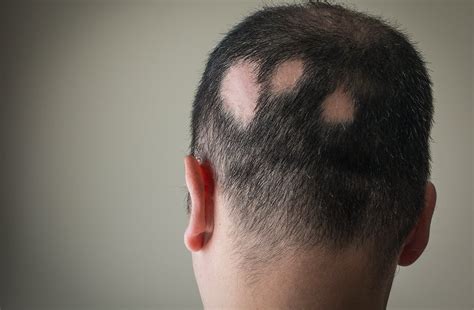Introduction

Bald head patches, medically known as alopecia areata, can be a significant source of distress for both men and women. This condition causes round or oval patches of hair to fall out, leaving the affected area smooth and hairless. While bald head patches can occur anywhere on the body, they are most commonly found on the scalp.
Causes of Bald Head Patches
The exact cause of bald head patches is unknown, but it is believed to be an autoimmune disorder. This means that the body’s immune system mistakenly attacks its own hair follicles, causing them to stop producing hair.
Risk Factors
Certain factors can increase the risk of developing bald head patches, including:
- Family history: People with a family history of bald head patches are more likely to develop the condition themselves.
- Certain medical conditions: Bald head patches can be associated with certain medical conditions, such as thyroid disease, lupus, and diabetes.
- Medications: Certain medications, such as chemotherapy, can cause hair loss.
- Stress: Severe stress can trigger bald head patches in some people.
Symptoms
The primary symptom of bald head patches is the sudden appearance of round or oval patches of hair loss. These patches can range in size from small to large and may appear anywhere on the body. Other symptoms may include:
- Itching or burning sensation: In some cases, bald head patches may be accompanied by itching or burning sensations.
- Pain: Bald head patches are typically not painful, but some people may experience mild discomfort.
Diagnosis
Bald head patches are typically diagnosed based on a physical examination. Your doctor may also order blood tests to rule out any underlying medical conditions.
Treatment
There is no cure for bald head patches, but treatment can help to slow or stop hair loss and promote hair regrowth. Treatment options include:
- Medications: Topical or oral medications, such as minoxidil or finasteride, can be used to stimulate hair growth.
- Immunotherapy: Immunotherapy is a treatment that helps to suppress the immune system and prevent it from attacking hair follicles.
- Light therapy: Light therapy uses ultraviolet light to slow hair loss and promote hair regrowth.
- Hair transplant: In some cases, hair transplant surgery may be an option to restore hair growth to bald head patches.
Prevention
There is no sure way to prevent bald head patches. However, there are some steps you can take to reduce your risk, including:
- Manage stress: Stress can trigger bald head patches in some people. Find healthy ways to manage stress, such as exercise, yoga, or meditation.
- Avoid harsh hair treatments: Avoid using harsh hair treatments, such as chemical hair dyes or relaxers, which can damage hair follicles.
- Protect your hair from the sun: Sun exposure can damage hair follicles and increase the risk of bald head patches. Wear a hat or use sunscreen to protect your hair from the sun.
Solutions
If you have bald head patches, there are a number of solutions available to help you regain confidence, including:
- Hairpieces: Hairpieces, such as wigs or toupees, can provide a temporary or permanent solution for bald head patches.
- Hair implants: Hair implants are artificial hair fibers that can be surgically implanted into the scalp to create a natural-looking appearance.
- Scalp micropigmentation: Scalp micropigmentation is a cosmetic procedure that uses tiny dots of pigment to create the illusion of hair follicles.
Conclusion
Bald head patches can be a challenging condition to manage, but there are a range of treatments and solutions available to help you regain confidence and live a full life. If you are concerned about bald head patches, it is important to see a doctor to rule out any underlying medical
